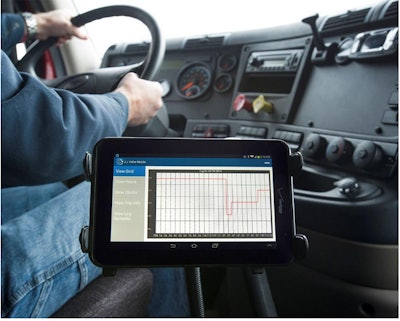
The call lasted several hours and “you couldn’t tell if they were listening or paying attention,” recalls Caskey, director of safety for the Minneapolis, Minn.-based flatbed carrier. In early March, AMMF discontinued this practice in favor of a custom, orientation training program from Instructional Technologies, Inc. (ITI).
Drivers now complete an interactive training program at their own pace, online, and have to answer questions correctly to proceed.
“We know there is comprehension plus they are able to view it as many times as they like. Before, they had one shot,” she continued. “It also provides a consistent message.”
The new training program made it possible for AMMF to shorten its orientation period by as much as one week. Previously, drivers could have completed a drug test and other pre-employment work by Thursday, for example, and then wait until the following Wednesday for the training meeting before they could be dispatched on their first load.
Online training not only condenses the hiring process; it also skirts the boundaries of time and geography to get training out to drivers at the right moment. And by all indications, motor carriers will be using it to reach drivers faster and more frequently than ever before.
According to the most recent estimates by the American Trucking Associations, truckload fleets could immediately fill 35,000 to 40,000 driving positions not counting those seats they need to fill because of turnover, which has increased to an annual rate of 90 percent or more, on average.
Reaching more drivers

The company also uses online courses from Vertical Alliance for remedial training. Kiosks are set up in all terminals, shops and warehouses. Drivers can also complete training using their own computers. If a driver has an hours-of-service or maintenance violation, for example, they are assigned courses on these topics. Also, if drivers miss a required quarterly safety meeting they must complete a course on a topic that was discussed at the meeting.
Drivers for Brown Integrated Logistics took more than 5,000 courses last year, he says. The fleet has about 1,000 drivers, 440 of which are owner-operators. “Acceptance of Vertical Alliance as a tool has improved dramatically. There is no resistance,” he continued. And once drivers complete a course after a violation, “we don’t have many repeat violators in any particular item.”
Integrated training
Some of the companies that develop content and technology for online training are working on the next evolution: a closed loop process. Whereas fleet managers have to manually assign training courses to drivers today, in the future, training will be automatically assigned or at least recommended to drivers based on individual circumstances.

J.J. Keller is working to make training content more closely integrated with its end-to-end compliance management platform, he says, which includes an Electronic Logging Device (ELD) that uses smartphones and tablets for a display; a back-office driver management system, Encompass; and the Training on Demand courses.
When a violation is detected, such as a driver going over his limits for hours of service or not completing a pre-trip inspection, a fleet manager could assign a recommended course to the driver through an integrated workflow.
“The vision is to close the gap between gathering data and pushing back training to the driver,” he says.
About 1.5 years ago, ITI rebuilt its Pro-Tread training courses using HTML-5 to be mobile friendly. Previously its courses were designed using Adobe Flash which was not always compatible with mobile devices, says Thom Schoenborn, vice president of marketing for ITI.
ITI is now working with the major providers of mobile fleet management platforms to connect data — such as the conditions surrounding a hard braking or speeding event — to an action in the form of a training course. Perhaps winter weather was also a factor in the event, in which case a driver might need to complete a course in winter driving as well as a course on space management.
Schoenborn predicts that this next phase in the evolution of Pro-Tread, called “directed training,” will be ready within 18 months.
Next week, CCJ will explore additional technologies such as video recording devices and advanced scoring systems that are now being used by fleets to make their driver training programs more efficient and effective.










